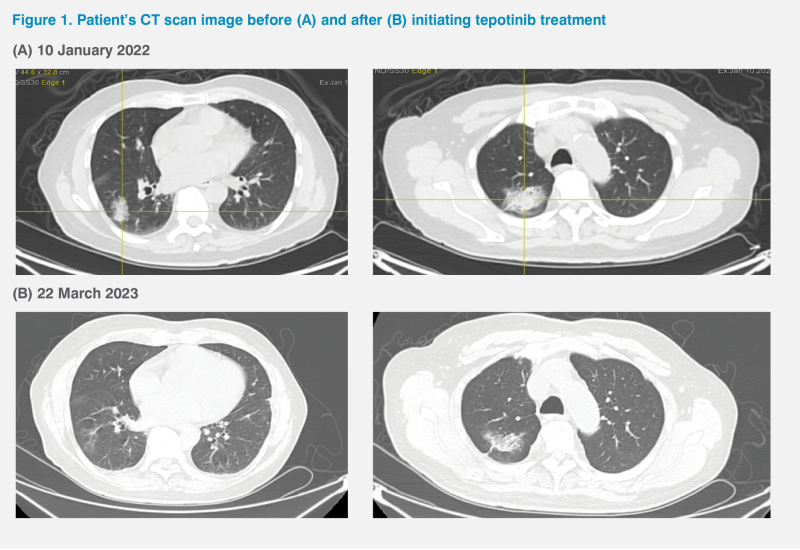Use of a MET inhibitor in a patient with newly diagnosed advanced NSCLC with METex14 skipping mutation





Presentation and investigations
An 80-year-old Chinese male, a long-term smoker with no significant medical history, was found to have a right lung mass on a routine chest X-ray in August 2021. A CT scan of the chest revealed a dominant right lower lobe mass (3.3 x 2.3 x 2.7 cm) with multiple bilateral lung nodules. CT-guided fine needle aspiration cytology (FNAC) of the right lower lobe mass performed on 2 December 2021 confirmed adenocarcinoma, while a PET-CT scan on 10 January 2022 showed a right lower lobe tumour with metastases to the left hilar and mediastinal lymph nodes and both lungs. (Figure 1A) Next-generation sequencing (OncoSnap Nonet) identified MET exon 14 (METex14) skipping mutation. The programmed death ligand 1 (PD-L1) tumour proportion score (TPS) was 0 percent. The patient was diagnosed with stage IV non-small-cell lung cancer (NSCLC) harbouring a METex14 skipping mutation. His Eastern Cooperative Oncology Group performance status (ECOG PS) was 0.

Treatment with tepotinib
The patient began treatment with tepotinib (450 mg QD) on 29 March 2022. Reassessment CT scan on 20 September 2022 showed responding disease with reduction in size of all lung metastases and mediastinal lymph nodes. His disease remained stable, as confirmed by a subsequent CT scan on 22 March 2023. (Figure 1B)
The patient tolerated tepotinib well, except for persistent lower limb swelling (grade 2) extending to the shin, which began a few months after starting treatment. This was managed with furosemide 20 mg QD, which reduced the swelling to grade 1. Subsequently, he tolerated the full dose of tepotinib well without interruption or dose adjustment.
CT scan in January 2024 revealed progression of the right lower lobe nodule, which increased from 0.8 to 1.1 cm. All other sites, including the brain, chest, and abdomen, remained stable with no new metastases. In March 2024, the patient received stereotactic body radiotherapy (SBRT; 50 Gy in 5 fractions) to the right lung nodule, which had oligoprogression.
Three months later, the patient developed shortness of breath, cough and increased production of whitish sputum. CT scan in June 2024 showed right lower lobe consolidation with partial right middle lobe collapse, compatible with radiation-induced pneumonitis. Since the possibility of drug-related pneumonitis could not be ruled out, tepotinib was temporarily withheld. The patient was given a course of prednisolone from 17 June to 22 July 2024. His symptoms gradually improved and he was successfully weaned off the steroid. Follow-up CT scan on 27 August 2024 showed persistent right lower lobe consolidation, but the inflammatory changes had resolved, indicating control of radiation-induced pneumonitis. Full-dose tepotinib was resumed, and the patient maintained good disease control with mild lower limb oedema managed with furosemide. His ECOG PS remained 0 throughout treatment. At his last visit on 22 April 2025, his condition was stable. The plan was to continue tepotinib with regular follow-up and imaging monitoring.
Discussion
In Hong Kong, all newly diagnosed stage IV NSCLC cases typically undergo molecular tests to identify targetable genetic alterations. The prevalence of METex14 skipping mutations among Asian patients with NSCLC is about 1–2 percent.1 The current guideline-recommended standard of care for patients with METex14 skipping NSCLC includes a MET inhibitor, such as tepotinib or capmatinib, as data regarding efficacy of immune checkpoint inhibitor (ICI) monotherapy and chemotherapy–ICI combinations are very limited in these patients.2,3
The VISION study, a phase II, single-arm, open-label, multicohort trial, supports tepotinib use in advanced METex14 skipping NSCLC (cohort A: n=152, >35 months follow-up; cohort C: n=161, >18 months follow-up).4,5 After a median follow-up of 32.6 months, tepotinib showed robust efficacy with an objective response rate (ORR) of 51.4 percent, median duration of response (mDoR) of 18.0 months, median progression-free survival (mPFS) of 11.2 months, and median overall survival (mOS) of 19.6 months.5
In a subgroup analysis of Asian patients (n=106), tepotinib demonstrated durable activity with an ORR of 56.6 percent (64.0 percent in treatment-naïve patients [n=50]; 50.0 percent in previously treated patients [n=56]).6 The mDoR, mPFS, and mOS were 18.5, 13.8, and 25.5 months, respectively.6 In our patient, SBRT for oligoprogression extended tepotinib’s disease control to at least 36 months, surpassing VISION study outcomes.
Common treatment-related adverse events (TRAEs) in Asian patients included peripheral oedema (62.3 percent), elevated blood creatinine (38.7 percent), and diarrhoea (32.1 percent).6 Peripheral oedema, as seen in our patient, can be managed with furosemide. Health-related quality of life remained stable, with some improvement in cough, dyspnoea, and chest pain.6 Other manageable side effects that have been observed in our patients include malaise (addressed with lifestyle changes), non-progressive renal impairment (stabilized conservatively), and diarrhoea (controlled with loperamide 2 mg as needed).
While our elderly patient could tolerate the full dose of tepotinib thanks to his excellent PS, caution is advised in frailer patients, or in those with renal or liver impairment, in whom a MET inhibitor can be initiated at a lower dose to reduce the risk of side effects.
Due to the possibility of immune-related recall reaction in patients who previously received immunotherapy, we recommend a washout period of 1–2 months before starting MET inhibitor treatment.
In summary, the present case highlights the importance of upfront genetic testing (eg, next-generation sequencing) in identifying patients with METex14-mutated NSCLC, which would allow timely initiation of targeted therapy with proven durable clinical activity, such as tepotinib or capmatinib. The strategic use of local therapies, such as SBRT for oligoprogression, complements targeted therapy, significantly extending disease control.